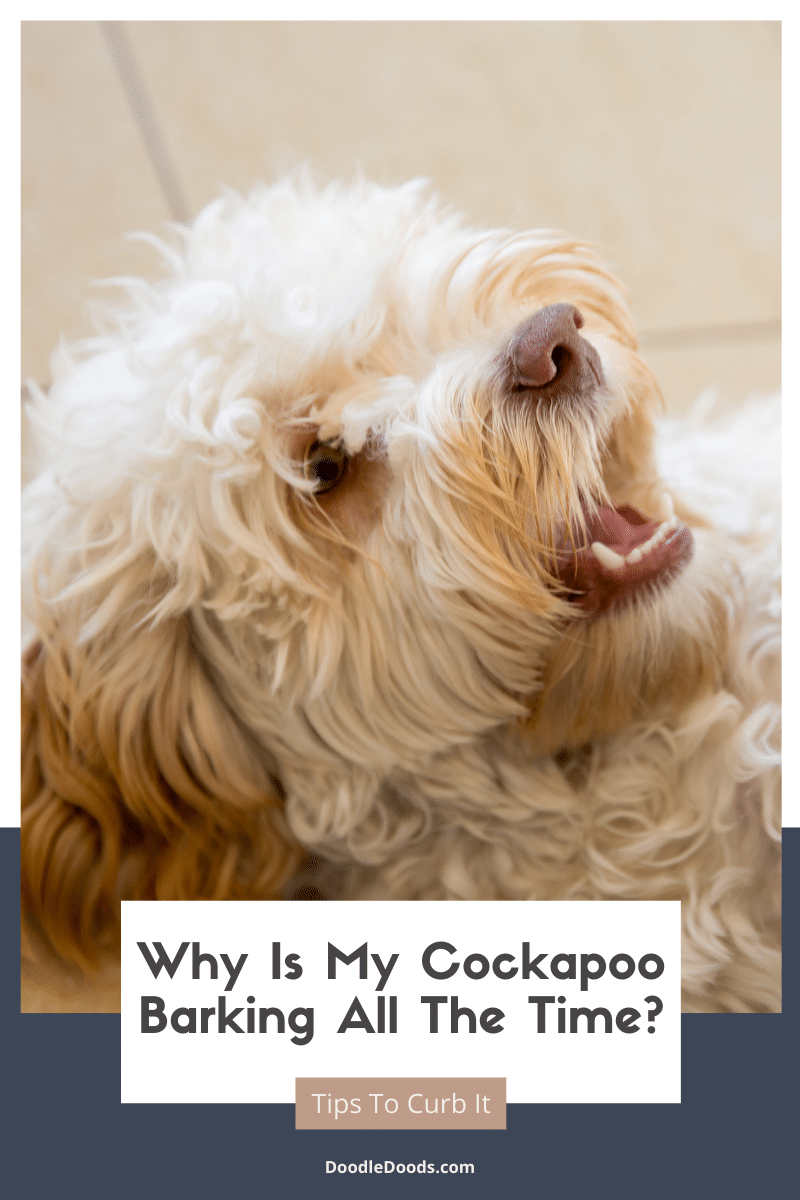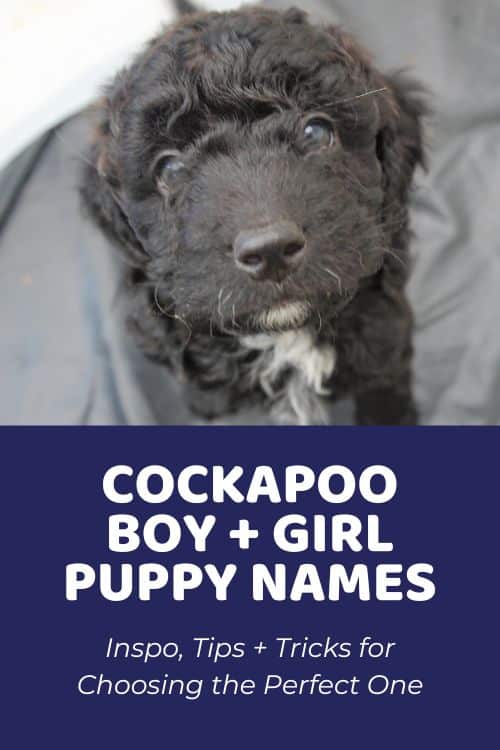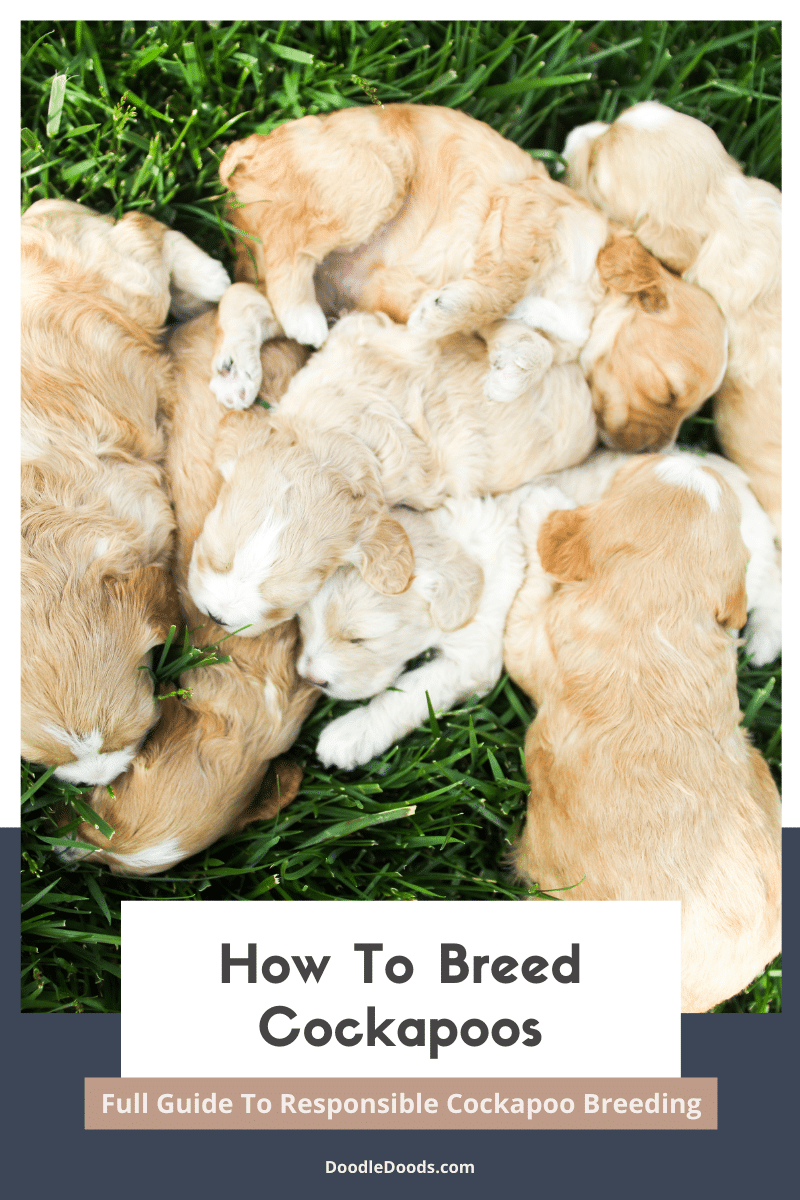To dock or not to dock the Cockapoo tail? That’s the question we’re going to answer for you in the following article. Cockapoo tails come in all shapes and sizes, covered in different types of fur and also ranging in length. But what’s the natural state of a Cockapoo’s tail? And do Cockapoos have tails? In this guide, you’ll learn all about Cockapoo tails, including information about Cockapoo tail docking and whether or not you should consider it.
Table of Contents
- Cockapoo Tail Docking: Introduction
- What Is Tail Docking In Dogs?
- Is Tail Docking Illegal?
- Should I Dock My Cockapoo’s Tail?
- Cons Of Docking Your Cockapoo’s Tail
- How To Dock A Cockapoo’s Tail?
- Recovery After Docking Your Cockapoo’s Tail
- Cockapoo Tail Docking: FAQs
Cockapoo Tail Docking: Introduction
The adorable Cockapoo, a.k.a the Cocker Spaniel-Poodle mix is one of the most well-known Doodle breeds. They’re small and lively, loving and intelligent, and overall just wonderful pets for almost anyone to have. They’re also widely praised for their hypoallergenic coats, which means that they don’t shed heavily and make great companions for people who are allergic to dog hair and dander.
The Cockapoo tail is naturally medium length and covered in fluffy hair that’s usually either curly or wavy. But perhaps you’ve noticed that some Cockapoos sport a much shorter tail? Most of the time, that’s the result of Cockapoo tail docking.
But while tail docking is a common practice amongst certain breeders and within specific breeds, it does pose a range of risks and issues. Today, tail docking isn’t even legal in many countries across the globe. But should you have your Cockapoo’s tail docked or not? Would your pup benefit from it or is it an outdated and inhumane practice? Let’s find out…
What Is Tail Docking In Dogs?
Tail docking is a surgical procedure where a dog’s tail is surgically shortened or in some cases almost completely removed. It’s done under general anesthesia, making it a serious medical procedure.
In today’s world, tail docking has become a controversial topic. However, some breeders still opt to dock their puppies’ tails due to certain breed standards or historic reasons. For instance, dogs that were originally bred and trained to hunt or protect often had their tails docked for their own safety and comfort. Nonetheless, it’s not always done for practical purposes, as some dogs have their tails docked for purely cosmetic reasons.
For example, the American Kennel Club (AKC) requires their show Poodles and Cocker Spaniels to have docked tails. Interestingly enough, the Cocker Spaniel is a part of the AKC Sporting Group and the reasoning behind docking a Cocker Spaniel’s tail is this:
“Sporting Group breeds, such as spaniels, often go into thick brush to track game. While some of these breeds (such as Labrador Retrievers) have thick, strong tails or tails with thick hair, other breeds have weaker tails with often wispy hair that are prone to injury when they run through thick brush or brambles.” (Source)
Considering their Cocker Spaniel and Poodle heritage, the Cockapoo docked tail isn’t that uncommon of a practice. But is it necessary? That’s up for debate. Cockapoos are most commonly bred as companionship pets, meaning that they won’t exactly do “hard work” that puts their fabulous tails in jeopardy. Indeed, they are quite active dogs, but this might not be much of an issue for their tail health.
Is Tail Docking Illegal?
In many parts of the world, tail docking is an illegal or restricted practice. In the US, Cockapoo tail docking is unrestricted, but some states have made strides towards banning this practice. Some states also have their own regulations stating that the practice is allowed only for practical and medical reasons. In the UK, Australia, and the European Union Countries tail docking is banned when it’s done for non-medical reasons. Obviously, these bans also cover Cockapoo tail docking.
By the way, if a dog’s tail is removed due to medical reasons, it’s actually called tail amputation. Indeed, even tail docking may be necessary in certain cases, such as to prevent injuries in working dogs or due to a pre-existing injury. But all in all, in the past this practice has been mostly due to cosmetic reasons and there isn’t sufficient evidence to suggest that pet dogs will benefit from tail docking.
Should I Dock My Cockapoo’s Tail?
There really isn’t a reason for you to have your Cockapoo’s tail docked if it’s purely for cosmetic reasons or if you fear that maybe something could happen to their tail in the future. Many dogs have long tails and it’s simply a part of their body. They use it to express their emotions and it’s a way for them to communicate with us.
On the other hand, if your Cockapoo’s tail has gotten injured or there are some other health issues at play, your vet may discuss tail amputation with you. In some cases, amputating a Cockapoo’s tail could prevent chronic infections and pain after tail injuries.
Another reason for docking a Cockapoo’s tail would be to manage their “happy tail syndrome”. Again, the constant wagging and hitting of the tail may cause persistent injuries and infections and would therefore qualify as a medical concern.
Some proponents of tail docking in dogs also claim it to have positive effects on a dog’s hygiene. To be fair, you do have to clean your Cockapoo with the tail docked a bit less simply because there’s less of the tail to groom and keep clean. But if you’re already having to groom your Cockapoo, the tail part of it isn’t exactly extra work for you anyway.
Some people also believe that since Cockapoos are the Poodle and Cocker Spaniel’s offspring, they should follow suit according to the AKC breed standards. But remember that Cockapoos and other hybrid breeds aren’t considered separate standalone breeds and therefore there are now breed standards to adhere to.
Cons Of Docking Your Cockapoo’s Tail
One of the main reasons against docking a Cockapoo’s tail is the fact that most of the time it’s just not necessary. There’s no reason for you to have your Cockapoo’s tail docked for cosmetic purposes nor is there any guarantee that it will somehow prevent issues later in their life. But besides that, there are more valid reasons for you to carefully consider. Here they are…
Cockapoo Tail Docking Is Costly And Painful
Cockapoo tail docking is a serious medical procedure that’s generally done under anesthesia. It should only be performed by a licensed veterinarian who has extensive knowledge and experience in such procedures. As you can imagine, the cost of having your Cockapoo’s tail docked can be very expensive. Even regular vet check-ups and simple procedures can add up quickly, not to mention more serious surgical operations like tail docking.
But let’s not forget that surgery is also painful for your pet. There’s a common misconception going around that a Cockapoo’s tail can be docked when they’re a young 3 to 5 day old puppy because their nervous system hasn’t fully developed yet. While tail docking is usually done in this timeline, there’s no guarantee that your pup won’t feel a thing or suffer from pain after the surgery. In most cases, the procedure isn’t done under general anesthesia, which can also increase the pain a puppy feels when having their tail docked.
If your pooch does feel the pain of the procedure, it can have lasting effects on their psyche and emotional wellbeing. Dogs can remember trauma very well and it could severely affect them in a negative way for the rest of their lives.
Cockapoo Tail Docking Can Lead To Issues With Balance, Movement, And Communication
Probably every single one of us knows that a dog’s tail is a good indicator of their mood and emotions. Your pup will wag its tail when they’re happy to see you or having fun playing. They may put their tail between their legs when they’re scared or frightened. If it’s stiff and straight, your pooch might be feeling a bit sassy or even tense. If you learn your dog’s body language and behaviors, you’ll also notice how their tail changes according to their emotional state.
Fun fact – dogs also communicate with each other with their tails. Wagging the tail and holding it up higher spreads more of your dog’s unique scents that express from the anal glands.
What’s more, a dog’s tail is said to also play a role in their movement and balance. For example, a dog’s tail could help them move around and change direction, as the tail helps keep their balance. On the other hand, a recent study has shown that a dog’s tail might not have as much involvement in their balance and movement as it’s been thought to have so far. (Source)
Your Cockapoo Might Develop Health Issues
As with any serious medical procedure, a Cockapoo with its tail docked may develop health problems after the surgery. For one, it could lead to chronic pain and infections if the wounds don’t heal up as quickly or easily as initially hoped. Nerve pain is another issue that you should take into account with any surgical procedure. All of this can also lead to sensitivity to being touched and as a result affect how your pooch reacts to body handling.
Some also claim that it could affect a dog’s muscular development. Mainly, the pelvic muscles and therefore a dog’s continence. Yet again, the evidence for this isn’t conclusive and the underdevelopment of pelvic muscles and the consequent incontinence may actually be due to other variables.
How To Dock A Cockapoo’s Tail?
There are two ways how a Cockapoo’s tail can be docked – surgical removal and banding. The surgical removal is pretty straightforward. A veterinarian will use a scalpel and other surgical tools to remove the tail at a predetermined length, usually leaving a few inches of the tail intact. The remaining tail is then sutured together to prevent further bleeding and start the healing process.
The banding procedure involves a tight band that’s wrapped around the tail where the new tail length will be. The band is left on for a few days to cut off any blood supply, leading to gangrene and the extra portion of the tail falling off.
Keep in mind that you should never attempt to dock a Cockapoo’s tail on your own. If it’s a necessary procedure for your pup’s health, tail docking should only be performed by a licensed veterinarian. With adult dogs, this procedure is usually performed with the help of either local or general anesthesia. However, these heavy medications aren’t always used on young puppies, increasing the risk of any adverse side effects and severe pain for a puppy.
Recovery After Docking Your Cockapoo’s Tail
If for any reason your Cockapoo’s tail must be docked, you’ve also got to be extremely careful when following the post-op recommendations given to you by the vet. After all, it’s still a surgery and will require you to keep an eye on the healing of the tail and how your pup is feeling.
At any step of the recovery period, but especially during the first two weeks, keep a close eye on the surgical site. If you notice any signs of infection, such as bleeding, leaking of fluids, inflammation and swelling, or redness, immediately contact your vet for further guidance.
You should also make sure that your Cockapoo doesn’t lick, chew, or scratch its tail during the recovery period. It’s very common for dogs to start licking and chewing on their wounds, as it may help soothe the discomfort and pain. However, this can easily open up the wounds again and also cause infections due to bad bacteria getting into the wounds. To prevent this, your vet may require your dog to wear a cone, a recovery collar, or a surgical jacket.
Your vet may also prescribe medications like antibiotics to prevent infections and pain medications to manage the pain. If that’s the case, always give your pup the recommended dose, not any less and not any more. It’s crucial that you give your dog their prescribed amount to prevent overdose or to ensure that the medications are actually working for their size and age.
If your Cockapoo’s tail is covered in bandages, be sure to change them exactly as instructed by your vet. The surgical site has to be clean and properly cared for at all times. In some cases, it may also involve topical medications and ointments.
Cockapoo Tail Docking: FAQs
It’s thought that the most humane way to dock a Cockapoo’s tail is to do it between 3 and 5 days of age. However, during this early stage in puppyhood, general anesthesia is rarely used due to the risks involved. Sometimes even local anesthesia isn’t used on such young puppies and it will therefore be extremely painful for a puppy. If for any medical reasons your adult Cockapoo’s tail needs to be docked, this can be done at any age. Fortunately, anesthesia is commonly used on adult dogs and it will greatly reduce the pain and trauma your dog will experience during the procedure.
Cockapoo tail docking is a serious medical procedure and it requires a lengthy recovery period. The full healing period is usually several weeks and up to a few months. Some puppies or dogs may also heal a bit slower, making the recovery period even longer and more uncomfortable. But if all goes well, the hardest part of the healing process should be over after about a week or two.
A docked tail is the result of surgically removing a part of a dog’s tail. Dogs with bobbed tails have been selectively bred to have naturally short tails, without any external procedures involved. Some of these breeds include Australian Shepherds, Corgis, Old English Sheepdogs, or even Labrador Retrievers.
Cockapoo Tail Docking: Final Thoughts
All in all, Cockapoo tails are fabulous on their own, without any need for surgical involvement. To be fair, Cockapoo tail docking is a rather outdated practice that stems from breed standards set for their purebred Poodle and Cocker Spaniel parents. But as Cockapoos are bred for companionship, there’s really no reason for you to have your Cockapoo’s tail docked other than aesthetic purposes.
While we cannot make the law in the US, tail docking practice is considered cruel in many other countries. In the UK, Australia, and many of the European countries, tail docking is illegal unless it’s done for a medical purpose. Ultimately, it’s up to you whether or not to have your Cockapoo’s tail docked. But, relying on sufficient scientific data and countless resources from veterinarians and other dog professionals, there really aren’t many health benefits to tail docking.
If for any reason you’re planning to have your Cockapoo’s tail docked, be sure to only trust this procedure into the hands of a licensed veterinarian. Any and all medications and anesthesia options should be considered to minimize your dog’s pain and suffering during this serious surgery. And, of course, don’t forget to pay close attention to your dog’s recovery and healing process, including keeping their surgical site clean and wounds intact.
We hope this article has helped you decide whether or not you should have your Cockapoo’s tail docked and also give you some insights as to how the procedure works and what are the risks involved. Also, keep in mind that some breeders still have their puppies’ tails docked, so that’s another thing to consider before adopting a Cockapoo from a specific breeder.
Learn How to Upkeep Your Doodle!

A Maintenance Grooming Guide to Keeping Your Dood Looking as Perfect as They Do on Grooming Day!
Plus, get $355 worth of Bonus Materials for FREE, including:- Doodle Parenthood Community and Support Group ($190 value)
- Video on Trimming Overgrown Eyebrows, Jowls, and Beard ($30 value)
- Video on What Improper Brushing Looks Like ($20 value)
- Easy to Use Doodle Grooming Tracker ($20 value)
- And MORE!









